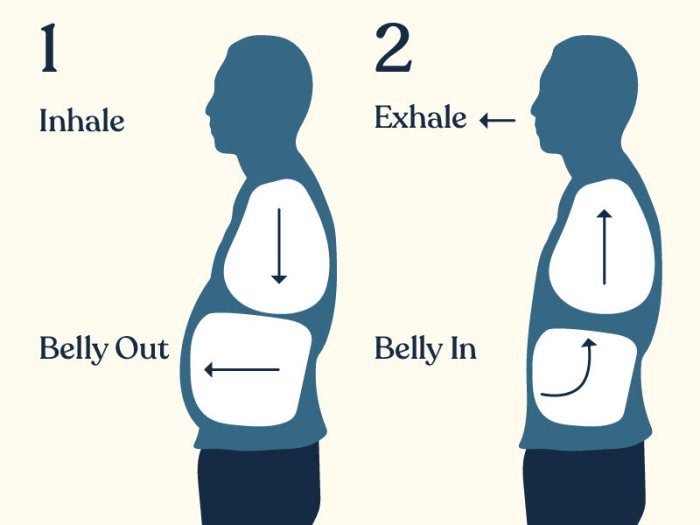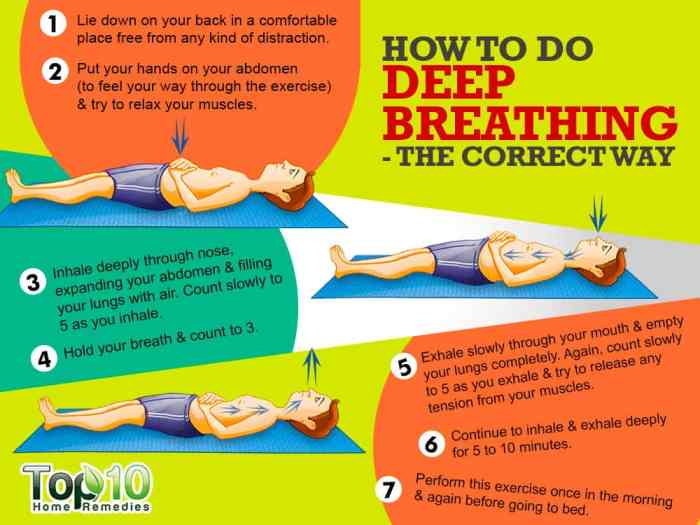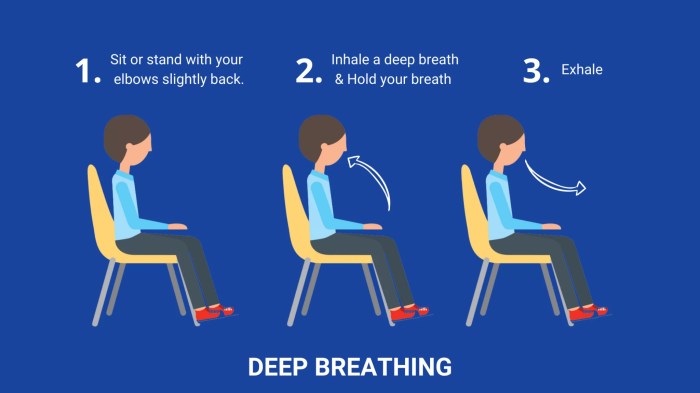Embark on a journey with Deep breathing exercises for meditation, exploring how this practice can transform your focus and alleviate stress. Discover the profound impact of intentional breathing techniques on your overall well-being and mental clarity.
Delve into the world of deep breathing and meditation as we uncover the secrets to unlocking inner peace and heightened awareness through simple yet powerful exercises.
Benefits of Deep Breathing Exercises for Meditation

Source: cloudfront.net
Deep breathing exercises play a crucial role in enhancing the meditation experience by calming the mind and body. Let’s explore the various benefits of incorporating deep breathing into your meditation practice.
Physiological Effects of Deep Breathing during Meditation
- Deep breathing increases oxygen flow to the brain, promoting relaxation and reducing stress levels.
- It activates the parasympathetic nervous system, leading to a decrease in heart rate and blood pressure.
- Deep breathing helps release endorphins, the body’s natural painkillers, promoting a sense of well-being.
Reduction of Stress and Anxiety
- By focusing on deep breathing, individuals can redirect their attention away from stressors and anxious thoughts.
- It helps regulate the production of cortisol, the stress hormone, leading to a more relaxed state of mind.
- Deep breathing techniques can create a sense of mindfulness, allowing individuals to stay present and let go of worries.
Impact on Focus and Concentration during Meditation
- Deep breathing exercises help clear the mind of distractions, improving the ability to concentrate on the present moment.
- By syncing breath with movement or a mantra, individuals can enhance their focus and deepen their meditation practice.
- Consistent deep breathing can improve cognitive function and memory, aiding in overall mental clarity.
Types of Deep Breathing Techniques

Source: squarespace-cdn.com
Deep breathing techniques play a crucial role in meditation, helping individuals relax their minds and bodies. There are various types of deep breathing exercises that are suitable for meditation, each offering unique benefits and effects.
Diaphragmatic Breathing
Diaphragmatic breathing, also known as deep belly breathing, involves breathing deeply to expand the diaphragm and fill the lungs with air. This technique is especially effective for calming the mind, reducing stress, and promoting relaxation during meditation. By focusing on the movement of the diaphragm, individuals can enhance their breath awareness and deepen their meditation practice.
Box Breathing
Box breathing, also referred to as square breathing, is a technique that involves inhaling, holding the breath, exhaling, and holding the breath again in a pattern resembling a square. This method helps in balancing the autonomic nervous system, reducing anxiety, and improving concentration during meditation.
4-7-8 Breathing
-7-8 breathing technique involves inhaling for a count of 4, holding the breath for a count of 7, and exhaling for a count of 8. This breathing pattern is effective in calming the mind, alleviating stress, and enhancing focus and mindfulness during meditation sessions.
Alternate Nostril Breathing
Alternate nostril breathing is a pranayama technique that involves breathing through one nostril at a time while blocking the other nostril. This practice aims to harmonize the energy flow in the body, clear the mind, and promote relaxation and balance during meditation.
Equal Breathing
Equal breathing, also known as sama vritti in yoga, involves inhaling and exhaling for an equal count. This technique helps in calming the mind, improving concentration, and enhancing breath control for a more profound meditation experience.
Steps to Perform Deep Breathing Exercises for Meditation

Source: emeryreddy.com
To start deep breathing for meditation, follow these steps to ensure an effective practice:
Correct Posture and Breathing Rhythm
- Sit in a comfortable position, either cross-legged on the floor or in a chair with your feet flat on the ground.
- Keep your back straight and shoulders relaxed to allow for better airflow.
- Close your eyes and begin by taking slow, deep breaths in through your nose, allowing your abdomen to expand.
- Exhale slowly through your mouth, releasing any tension or stress with each breath.
- Focus on the rhythm of your breathing, aiming for a steady and controlled pace.
Creating a Conducive Environment
- Choose a quiet and peaceful space where you won’t be disturbed during your meditation practice.
- Dim the lights or light a candle to create a soothing atmosphere.
- Play soft instrumental music or nature sounds to enhance relaxation and focus.
- Avoid distractions such as phones or other devices, and set aside dedicated time for your deep breathing meditation.
Common Mistakes to Avoid in Deep Breathing Meditation

Source: zenfulspirit.com
When practicing deep breathing for meditation, it is important to be mindful of common mistakes that can hinder the experience. Incorrect breathing techniques can impact the effectiveness of your meditation session, leading to reduced benefits. By recognizing these errors and making adjustments, you can enhance the quality of your deep breathing exercises for meditation.
1. Shallow Breathing
- Shallow breathing involves taking quick, shallow breaths from the chest rather than deep, slow breaths from the diaphragm.
- This can limit the amount of oxygen reaching your body and brain, reducing the relaxation and calming effects of deep breathing meditation.
- To rectify this mistake, focus on breathing deeply into your belly, allowing it to rise and fall with each breath.
2. Holding Your Breath
- Some individuals tend to hold their breath at certain points during deep breathing exercises, disrupting the flow of oxygen and relaxation.
- Avoid pausing or holding your breath between inhalation and exhalation to maintain a steady rhythm and flow of air.
- Remember to breathe continuously and smoothly throughout the meditation practice.
3. Overthinking and Lack of Focus
- Overthinking or losing focus during deep breathing meditation can lead to distractions and prevent you from fully experiencing the benefits.
- Try to stay present and focused on your breath, letting go of any racing thoughts or worries that may arise.
- Practice mindfulness and bring your attention back to your breath whenever your mind starts to wander.
Wrap-Up

Source: thehomerehabnetwork.com
In conclusion, Deep breathing exercises for meditation offer a gateway to a calmer mind, improved concentration, and a more centered sense of self. By incorporating these practices into your daily routine, you can cultivate a deeper connection to your inner being and experience the transformative power of mindful breathing.